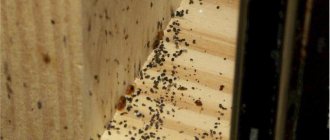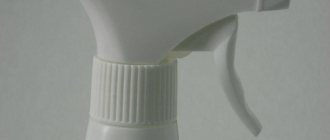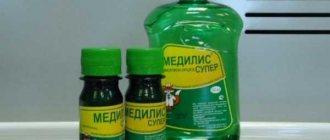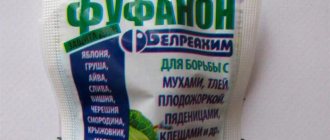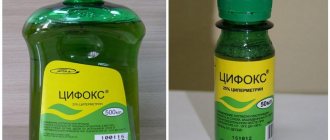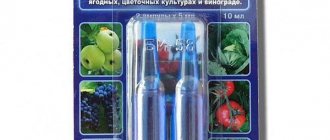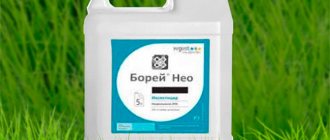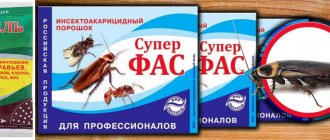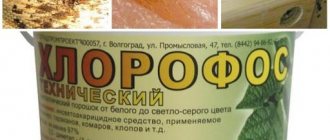Many summer residents have heard of such a drug as Bordeaux mixture. The use of fungicides in horticulture began with her. We tell you what Bordeaux mixture is, how to prepare it and use it correctly in the garden.
Known to many summer residents, Bordeaux mixture is the first fungicide in the world, which is still actively used to protect fruit and berry crops from fungal diseases. The mixture was invented in the 2nd half of the 19th century. French botanist P. Milliard, who lived in Bordeaux.
One of the first labels of Bordeaux liquid and a portrait of its inventor - Pierre Marie Millardet (1838-1902)
Nowadays, Bordeaux mixture is used to combat common plant diseases, such as:
- rust, scab, fruit rot, powdery mildew (in fruit and berry crops);
- macrosporiosis, late blight (in tomatoes, potatoes);
- septoria, downy mildew, anthracnose (in cucumbers);
- mildew (in grapes);
- spotting (in raspberries, strawberries), etc.
Active Ingredients
Bordeaux mixture consists of copper sulfate powder and lime mixture. The active components of the substance are copper compounds that are slightly soluble in liquid and provide long-term plant protection. In this case, lime and vitriol must be mixed immediately before use. The next day the components lose their properties.
Typically these components are sold in separate bags. If there is a lack of lime, there is a risk of crop burns. This is why it is so important to test for alkaline reaction. If there is not enough lime, it must be added.
What is Bordeaux mixture
Formula of the substance: CuSO4 • 3Cu(OH)2 = copper sulfate + calcium hydroxide. If the composition is prepared correctly, it has high adhesion and remains on the crown and leaves of crops for a long time.
Bordeaux mixture is a combination of 3 substances:
- lime powder;
- copper sulfate;
- water.
After dilution, the solution acquires a soft blue tint. The main component of the mixture is copper. Its deficiency does not have the best effect on the formation and fruiting of plants. This applies to a greater extent to plantings on peat and acidic sandy soils.
Copper in this preparation is an important trace element for the full development of plants. If a crop grows on soils with its deficiency, then growth slows down, yield decreases, branches and leaves become deformed. Therefore, treatment with the blue mixture is an excellent way to combat diseases and additionally nourishes the plants.
Benefits of Bordeaux mixture
Many gardeners regularly use Bordeaux mixture due to its universal properties and significant benefits. Its chemicals instantly contact the plant. An undoubted advantage is that the mixture is not washed off by rain.
The protective characteristics of Bordeaux mixture last for about 30 days, which serves as an advantage over other similar compositions. It is required to use the drug in early spring or late autumn - this is a necessary condition for its effectiveness.
The liquid is highly effective against many pathogenic microorganisms and pathogens. Use is recommended for scab, rust, black rot, late blight, leaf curl, and melanosis.
Disadvantages of Bordeaux mixture
Bordeaux mixture belongs to the group of high-contact pesticides, so careful treatment is necessary to combat garden diseases. The drug cannot be combined with organophosphorus liquids, as well as mixtures that degrade in an alkaline environment.
Benefits of Bordeaux mixture.
If you use the drug for spraying annually, then there is a high accumulation of copper in the ground and the garden plants themselves, which provokes poor ovaries and the death of young seedlings at the beginning of the season.
The disadvantages of using the mixture include phytotoxicity for garden crops during their active growth, from April to August. An active oxidative reaction when sprayed with Bordeaux mixture during rain causes burns and cracks to appear on the crown of plants.
Due to the copper content, the mixture is unsafe for human health. Experts strongly recommend the use of respirators when diluting the product and processing the garden. This will help avoid poisoning from chemicals. For the same purposes, it is necessary to carry out work with liquid only in calm, sunny weather.
Purpose
This remedy was invented by the French botanist Pierre Marie Millardet. Initially, the fungicide was used to protect and treat vineyards from the mold fungus Plasmopara viticola, which caused mildew.
Today, Bordeaux mixture is actively used in gardening in the fall. It can also be used in spring. The drug can be used for the treatment and prevention of fungal diseases in a wide variety of crops:
- late blight and macrosporiosis on tomatoes and potatoes;
- mildew on grapes;
- spotting of raspberries, strawberries, strawberries;
- fruit rot, scab, rust on fruit and berry crops;
- anthracnose, downy mildew, septoria on onions, cucumbers, garlic, carrots.
How can I replace the drug with analogues of the drug?
The popularity of this product among professionals and amateur gardeners is explained by its relative safety, accessibility, versatility and high efficiency. However, this fungicide is not unique, and there are many of its analogues on the market for similar drugs. The table provides information on pesticides that can replace Bordeaux mixture:
| Drug name | Manufacturer | Release form | Active ingredients | Hazard class for humans | Advantages |
| Cuproxat | Nufarm | Liquid | Tribasic copper sulfate | 3 |
Does not precipitate. |
| Abiga Peak | Agricultural chemistry | Copper oxychloride |
| ||
| Hom | Technoexport | Powder |
Compatible with other similar drugs. Does not cause addiction to pests | ||
| Polychomus | Green Belt | Copper oxychloride, polycarbacin |
| ||
| Oksikhom | Soyuzgrokhim | Copper oxychloride, oxadixyl |
|
How to make a solution
It is not difficult to dilute Bordeaux mixture. It is important to take care of your safety by following the cooking instructions:
- Perform all actions in protective clothing, be sure to use gloves, a respirator, and goggles;
- do not use containers with solution for other needs;
- Dispose of the remaining solution - to do this, it needs to be buried in the ground outside the boundaries of the garden.
The drug should be prepared directly on the day of use. If the work is planned to be moved, it is worth adding 5-10 grams of sugar to the composition.
To prepare a composition with a concentration of 1%, you need to do the following:
- Prepare 2 non-metallic containers. For this purpose, it is permissible to use enamel, glass or clay containers. Its volume should be at least 10 liters.
- Dissolve 100 grams of copper sulfate in 1-1.5 liters of hot water. After this, add 4 liters of cool water. It is recommended to do this gradually.
- In a second container, slak 100-150 grams of quicklime in water. To do this, add 1-1.5 liters of cold water. Then you need to gradually pour in 4 liters of cold water.
- Mix each solution thoroughly.
- Pour the copper sulfate solution into the container with lime in a thin stream and mix carefully. The result will be a bright blue liquid.
See also
Types and chemical formula of nitrate, composition and what the fertilizer is used for
Read
Then you need to check the vitriol content in the composition. To do this, you should lower an iron object there and look at it carefully. If copper deposits have formed on the metal, you need to add a small amount of lime to the composition. To make a 3 percent mixture, you need to use 300 grams of copper sulfate and 450 grams of lime.
Compound
Bordeaux mixture is an aqueous solution of copper sulfate and slaked lime (a solution of copper sulfate CuSO4 5H2O and calcium hydroxide Ca(OH)2).
When mixing lime milk and copper sulfate, a reaction occurs, during which copper sulfate is formed, which destroys fungi and suppresses the activity of pathogenic organisms.
Often a 1% Bordeaux mixture is used, which consists of:
- copper sulfate - 100 g;
- slaked lime 100 g, if quicklime - 150 g;
- water - 10 liters.
Dosage
Next, let's talk about how to dilute Bordeaux mixture . This process must be approached very responsibly, since each plant requires its own dosage of the product. In this case, it is important to observe the dosage of the product. If the wrong dosage is selected, irreparable damage to the plant can be caused.
The CORRECT dosage per 10 liters of water should be taken of slaked/quicklime and copper sulfate in the following proportions:
Flow calculation
Treating various plants and trees with Bordeaux mixture involves using a certain amount of solution. It is different for each culture:
- For 1 young tree up to 6 years old, use 2 liters of the mixture.
- For fruit-bearing plants, take 10 liters of the mixture.
- For 1 bush use 1.5 liters.
- To prevent diseases in grapes, raspberries and strawberries, use 1.5 liters per 10 square meters. meters.
- For tomatoes and cucumbers, use 2 liters. for 10 sq. meters of landings.
- For 10 sq. m. planting melons, watermelons, onions or beets use 1 liter of solution.
Instructions for use
Bordeaux mixture can be used in spring and autumn. Before the buds swell, it is worth using a composition with a concentration of 3%. During the active growing season, a 1% product is suitable. In autumn it is permissible to use a substance with a concentration of 3%. Autumn treatment will help protect pome and stone fruit plants from fungi.
For currants
Currant bushes can be treated with a solution of Bordeaux mixture to prevent spotting. The plantings should be sprayed for the first time in early spring. To do this, you need to use a solution with a concentration of 3%. For the next 2-3 treatments, prepare a 1% composition.
For tomatoes/tomatoes
If the first signs of pathologies appear on tomato seedlings, it is worth using a 1% Bordeaux mixture. This product should be used to treat the plantings using a spray bottle.
To prevent late blight and other diseases, spraying of tomatoes is carried out from the end of June or the beginning of July. In this case, it is worth using 1.5-2 liters of solution per 10 square meters. In total, the plants need to be treated 3-4 times. This is done every 10-14 days.
For trees
In the spring, before the buds open, the trees are sprayed with Bordeaux mixture at a concentration of 3%. In this case, 10-15 liters of fungicide should be applied to an adult tree, and 2-3 to a young tree.
Then, at the green cone stage, treatment is carried out with a 1% solution of the drug. The next time the substance is used after the trees bloom. Subsequent treatments are carried out at intervals of 10-15 days. During the season, the number of sprays should not exceed 6.
For potatoes
The first treatment is carried out before planting potatoes. To spray tubers, you should use a solution with a concentration of 1%. This should be done 1-1.5 hours before landing. When the bushes reach a height of 15-20 centimeters, the treatment should be repeated. In this case, you need to use 0.5-1 liter of mixture per 10 square meters. Treatment should be repeated after 12-15 days.
For strawberries
After the snow melts, garden strawberries need to be treated with a solution of Bordeaux mixture with a concentration of 3%. In this case, you need to use 0.5-1 liter per 10 square meters. Then, at the stage of foliage regrowth, spraying is repeated, reducing the concentration to 1%. Subsequent treatments are carried out at the stage of bud emergence and after harvesting. In such cases, a solution with a concentration of 1% is also used.
For cucumbers
Bordeaux mixture is used not only for the garden. Cucumbers can also be treated with this preparation. In this case, it is permissible to use a composition with a concentration of 1%. For 10 square meters, use 1.5-2 liters of the substance.
See also
Instructions for using Azofoska fertilizer for potatoes
Read
The first preventive treatment should be carried out at the stage of 2-3 true leaves. After which it must be repeated 2-3 times with an interval of 10-12 days. The last time spraying with Bordeaux mixture should be carried out 20-25 days before harvesting.
For grapes
In this case, a 3% Bordeaux mixture is applied at the green cone stage, until the buds have opened and only the green tip is visible. During the growing season it is worth using a weaker solution. It is important to spray the foliage from the outside and inside.
Reviews
Sergey, 45 years old Ekaterinburg
“I have had my own summer cottage for 15 years. Every year I plant plants - tomatoes, potatoes, beets, carrots, onions. In addition, there are many fruit and berry trees growing on my site. Yes, and there are grapes too.
Of course, it’s wonderful to have your own vegetables, fruits and berries, but in the first year I encountered an unpleasant problem - fungal infections of plants. I struggled with them for a long time. I did treatments, sprayed the entire area, but for some reason they did not bring the desired result. As a result, the yield decreased significantly.
One day on the Internet I read about such an effective remedy as Bordeaux mixture and decided to try it next year. Once early spring arrived, I gave all my trees a full treatment right before flowering.
I also treated with a weak solution in the summer. As a result, my plants do not get sick, and I get good harvests. I use this product all the time and recommend it to everyone!”
Irina, 48 years old, Krasnodar
“My husband and I have a private house, and there is a vegetable garden in the yard. We have been planting vegetable crops for almost 20 years, and we also have many fruit and berry plantations and flowers. Every year we are faced with problems such as fungal infections of plants, which cause a lot of trouble.
At first we could not completely exterminate them and as a result they reduced the yield, and some plants simply died. For a long time we could not find an effective remedy against these lesions. But somehow friends advised me to try Bordeaux mixture. Right when spring arrived, we treated all our trees with a 3% solution.
We also sprayed the plants with a 1% solution throughout the summer. As a result, our plants stopped getting sick, and the harvest became very good!”
Oleg, 54 years old, Kirov
“I have been growing fruit and berry trees for a long time. There are also a large number of strawberries and raspberries growing on my plot. At first, it took a long time to eradicate various plant diseases, which were very harmful and reduced productivity.
What I didn’t try then, various mixtures, preparations, powders. But for some reason they didn’t help much. Then my relatives gave me a Bordeaux mixture to try. After the first spraying, I began to notice that the diseases began to go away.
After 3 sprayings the plants became completely healthy. As a result, the harvest was good. Now I treat my area with this drug every year. He is the best!"
Svetlana 34 years old, Samara
“I have been growing vegetables, strawberries, fruit and berry plants for 5 years now. I always dreamed of having everything that was my own and natural. So I bought a dacha and decided to grow vegetables and fruits. However, in the first year I encountered such an unpleasant problem as fungal infections. They were especially pronounced on raspberries, strawberries, grapes and tomatoes.
My husband and I struggled with them for a long time, but for some reason modern medications did not help. We sprayed and sprinkled with powder mixtures, but in the end the diseases did not subside. One day I found a Bordeaux mixture in a specialty store and immediately decided to try it.
After 3 sprays our plants looked like new. As a result, our yield has increased. Now we use this product every year to treat our site. I recommend it to everyone, it’s a great mixture!”
Bordeaux mixture is an indispensable assistant for combating various fungal diseases of plants in a summer cottage or vegetable garden. It can completely eliminate them and increase the yield.
But during its use, you should follow the recommendations for its use, and you should not forget the concentration of the solution. Do not forget that excess copper sulfate can harm plants.
Precautionary Techniques
When using the solution, it is important to adhere to safety rules. In this case, the following rules should be observed:
- Use personal protective equipment. In this case, you should use gloves, a hat, special clothing, and a respirator.
- Do not drink, do not eat, do not smoke between sprays.
- Do not spray the composition close to fruits, berries and vegetables that are planned to be collected in the next 2-3 weeks. Before consumption, thoroughly wash fruits, vegetables and berries.
- Do not apply treatment during the flowering period of plants.
- Do not treat plants in strong winds, heavy dew or during precipitation.
- Do not mix Bordeaux mixture with other substances, as this will reduce the effectiveness of the product.
- Do not add soap solution to the composition to improve adhesion. This will reduce the effectiveness of the drug.
- The last spraying should be carried out 2 weeks before harvesting.
Security measures
When working with such a solution, you should adhere to safety rules. For humans, Bordeaux mixture is moderately toxic. During preventive maintenance you should wear:
- respirator,
- glasses,
- latex gloves.
If this solution enters the gastrointestinal tract, weakness, dizziness, nausea, loss of appetite, vomiting, abdominal pain, thirst, and indigestion occur. Each person's reaction to contact with the mixture may be different. There is a chance that the temperature will be below 36 degrees. It is recommended to rinse the stomach with warm, boiled water. Without using a respirator, you may feel chills, irritation of the larynx, fever up to 39 degrees, and sweating.
Possible mistakes
When using Bordeaux mixture, many gardeners make some mistakes. This provokes negative consequences. The most common problems include the following:
- violation of dosage - the concentration of the active substance more than 3% poses a danger to plants;
- use of a large amount of substance during processing;
- neglect of personal protective equipment;
- processing of crops during flowering;
- processing of vegetables and fruit plants before harvesting.
It is important to consider that processing plants during the flowering period does not harm the crops themselves, but the bees. Copper sulfate, which is part of the drug, kills insects. This has a bad effect on pollination and leads to a decrease in yield.
Action of Bordeaux mixture
The drug contains copper sulfate (copper sulfate), which destroys various types of fungi, and slaked lime (milk of lime), introduced into the composition so that the working solution does not drain from the leaves. That is why the drug ranks first among fungicides in terms of retention on leaves.
The effect of copper sulfate on fungal organisms has been known for a very long time, however, in addition to fungicidal, Bordeaux mixture also has insecticidal (repellent) properties, and this suggests the versatility of the drug.
- Instructions for use of Kleschevit
The protective effect of Bordeaux mixture can last up to 1 month.
Substitutes for the drug can be considered Abiga-Pik, Kuproksat and Khom, as well as the more advanced fungicides Polihom and Oksikh.
Cooking method
Bordeaux mixture can be purchased in specialized stores in the form of a water-suspension concentrate (WSC). The volume of the plastic bottle varies from 100 ml to 500 ml. To prepare a working solution, simply mix the contents of the bottle with clean water in the proportion indicated on the package. To obtain 1% liquid, you need to dissolve 100 ml of concentrate in 10 liters of water. To prepare a 3% working solution, you need 250 ml for the same amount of clean water.
Most often, gardeners prepare Bordeaux mixture on their own at home, using 3 ingredients. Depending on the crop being treated, the growing season and the purpose of spraying, a 1% or 3% solution is used.
Ingredients
On sale there is a one-component and two-component mixture for self-preparing protective equipment. In the first case, copper sulfate and lime are already mixed and packaged in a plastic bag. During storage, air and moisture penetrate the film, so the powder often contains lumps. Before diluting the dry mixture with water, it should be crushed until smooth. The resulting liquid can only be used for spraying with a broom or brush. The spray bottle quickly becomes clogged and stops functioning.
It is better to purchase components packaged separately. The kit includes sealed bags of copper sulfate and lime, as well as a litmus strip to monitor acidity levels. In addition, the packaging contains instructions for use, which should be followed when preparing Bordeaux mixture.
Utensils and protective equipment
The mixture must be prepared in enamel dishes or plastic containers. Metal buckets and pans cannot be used; their surface will react with the active ingredients and lead to the formation of a harmful substance. Copper sulfate and quicklime are initially mixed with water separately, so 2 containers should be prepared.
You can only start working with substances wearing gloves. It is recommended to take care of eye and respiratory protection. Otherwise, you may get burned or poisoned.
Step-by-step cooking instructions
1% Bordeaux mixture is prepared from 100 g of copper sulfate, 100 g of lime and 10 liters of pure water (not distilled). The process consists of several sequential steps:
- Pour copper sulfate into a prepared container and add 500 ml of warm water (40-50 °C).
- Stir with a wooden spatula until the crystals dissolve. You should get a clear blue liquid without sediment at the bottom.
- Add 4.5 liters of warm water, stirring constantly until the components are completely combined, cover with a lid.
- Pour lime into a container or bucket, “quench” 5 liters of hot water, stir thoroughly and strain. The result should be lime milk without lumps or sediment.
- Pour a warm solution of copper sulfate in a thin stream into the slaked lime. While adding, constantly stir the liquid until a homogeneous blue mixture is formed.
The pH level of properly prepared Bordeaux mixture is 6.5-7.5. To determine acidity, in addition to litmus paper, a nail is used. If after immersion a copper coating appears on it, it is necessary to increase the content of lime milk.
To prepare a 3% Bordeaux mixture, measure 300 g of copper sulfate and 400 g of quicklime per 10 liters of water. Mix using the same technology. More information on how to prepare a spray solution is described in the video:
Mode of application
To get the maximum effect and not harm the plants, you should pay attention to a number of points:
The product is used completely within 2-3 hours. There is no point in leaving the finished mixture for later use, because... it quickly loses its properties. Children and pets should not be in the area where work with Bordeaux mixture is carried out. Spray the plants on a windless day, at least 3 hours before rain. In sunny weather, spray in the morning (if there is no dew) or in the evening, after the sun leaves the area. This will avoid burning the leaves. Spray the solution over the entire surface of the shoots, including the back of the leaves and in hard-to-reach places
It is important to avoid liquid getting into the ground
Spraying is carried out during any growing season. The use of Bordeaux mixture in gardening is especially widespread in the spring, before the buds swell and in the fall, when perennial crops begin to prepare for the dormant period. At this time, the plants are treated with a 3% solution, and during the period of active shoot growth - with a 1% liquid.
Negative soil changes
Copper contained in some chemicals, including Bordeaux mixture, quickly accumulates in the soil and is slowly removed from it. This causes slow growth of cultivated plants, the formation of a large number of lateral branches on their roots, a noticeable reduction in yield and even death. That is why the use of Bordeaux mixture in gardening in spring and autumn should be carried out in strict accordance with the recommendations on the packaging.
Pros and cons of use
The positive effect of the drug on seedlings is due to its properties:
- quickly affects the bark of trees and their leaves;
- not washed off by rain;
- in acceptable concentrations it is harmless to plants;
- protects against infectious diseases for a month after spraying.
The disadvantages of the fungicide include:
- Inability to interact with pesticides, phosphorus-containing organic substances, as well as with compounds that can dissolve in alkali.
- Dependence of the degree of effectiveness of the solution on the intensity and quality of foliar spraying of seedlings.
- Negative impact on vegetation due to the accumulation of copper in the soil. If the permissible concentration of a microelement is exceeded, the plant begins to wither and eventually dies.
- The danger of penetration of active chemical elements into groundwater, which can lead to an imbalance of the entire ecosystem.
- Content of poison in solution. When it enters the respiratory tract and food tract of a person, irreversible processes in the body are triggered; Without medical care, death is possible.
- Possible plant burns due to improper preparation and application of the mixture.
- Difficulties in using liquid due to incomplete dissolution of lime, as solid particles clog the spray bottle.
Useful video
A video review from a famous expert will help you learn more about preparing Bordeaux mixture at home.
The use of Bordeaux mixture is one of the most effective ways to prevent and treat fungal diseases that affect crop plants. In addition to protective properties, the mixture has a stimulating effect. In order not to harm the plant and soil, the use of Bordeaux mixture must be carried out in strict accordance with the instructions for the drug and the consumption rates of the substance.
Previous
Tree care
